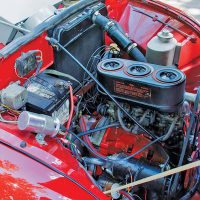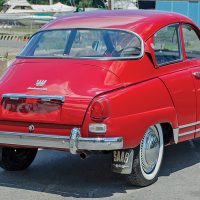"Underlig” is a Swedish word that means curious, odd, peculiar or strange. Any of those terms could fairly be applied to the venerable Saab 96 and its kindred. No matter how you look at it, these little cars are funky. They’re not as odd as the Messerschmitts and Isettas of the world, but they’re strange enough that Saabs have never really caught on as collector cars — even though they’re highly regarded among rally competitors for their sure-footed handling and excellent balance.
The Saab story
The Saab 96 was produced for 20 years from 1960 to 1980, but you could be forgiven for not noticing the differences between the 96 and its predecessor the 93, or the 92 before that. All the way back to the first production in 1949, Saab offered front-wheel drive and a 2-stroke engine in a package that looks for all the world like a turtle.
The package didn’t change substantially until the 4-stroke Ford V4 engine was introduced in 1967.
Saab came to America in 1957 with the 93 Model. American buyers were offered a 3-cylinder, 748-cc, 2-stroke engine rated at 33 horsepower. The car also had a 3-speed manual transmission with a non-synchro first gear — and a unibody design with coil-spring suspension all around.
In 1958, Saab added the Gran Turismo 750 model with a high-compression engine delivering 50 horsepower and 61 ft-lb of torque. It also featured front-disc brakes.
In 1960, the Saab 96 appeared, evolving the design a little further.
Base engine power was boosted to 42 horsepower, and U.S. buyers received a 4-speed transmission but still no synchronized first gear. The GT750 continued as the hot rod, and with the optional dual-carb “Super” kit, made up to 57 horsepower. For the 1963 model year, Saab bumped the displacement to 841 cc and announced the Gran Turismo 850 with triple carburetors, 57 horsepower and 68 ft-lb of torque. The GT 850 had a top speed of about 90 mph, a 0–60 mph time of 21.2 seconds, and got 26 miles per gallon.
At some point in the 1964 model year, the Gran Turismo 850 was renamed the Monte Carlo, in honor of the brand’s 1962 and 1963 victories at the eponymous rally. No major changes were made to the car beyond the name change.
You could buy a new 1964 Saab GT850 or Monte Carlo for $2,790. In comparison, a basic, 88-horsepower Porsche 356 coupe in the same era would cost you $4,195. Or you could buy an Austin Mini Cooper S for $2,181 and get 75 horsepower.
Our subject Saab GT850
Our subject sale was one of two Saab 96 GT850/Monte Carlo models sold at The Finest’s Aspen Auction on September 17, 2016. Our subject car, Lot 146, a 1964 Gran Turismo 850, sold for $30,800 — a fairly high price for the model. The other car was a 1965 Monte Carlo (Lot 101) that sold for $17,050. Both cars had been repainted and restored to generally excellent condition.
Looking at the available photos of our subject car, slight careless overspray can be seen on the wiring, and a discreet modern aftermarket electrical relay has been installed. That’s probably for the headlights or rally lights, as cars of this vintage often have all the headlight current running through the switch. Or it might serve the aftermarket horns visible near the grille.
One item that makes this car extra cool is the Halda Speed Pilot hanging under the dash. The Speed Pilot is a rallying device that allows the navigator to set the desired average speed on the left-hand dial, and then an extra speed hand on the clock to the right moves according to the car’s actual speed. The goal is to keep the speed hand aligned with the minute hand of the clock by driving the set average speed.
There’s also an adjustable odometer at the bottom of the Halda device. The Speed Pilot was standard equipment on the GT750 cars, but it became an option on the GT850 and Monte Carlo models.
With aftermarket horns, rally lights, no radio, and a Speed Pilot, you can safely draw one conclusion: This is the car you want for vintage rallies.
Checking the market
The 2016 SCM Pocket Price Guide lists the median price range for a desirable example of the 1965–67 Saab Monte Carlo 850 as $21,000, with a high sale of $40,700, but most sales fall short of that range. One prior online auction saw a sale price of $24,000 for an all-original 1973 survivor, but in most cases even good original examples of old Saabs trade below $10,000.
On the other hand, while the Saab 96 is by no means rare in general, most examples are equipped with the later 4-stroke V4 engines from the late 1960s and 1970s, and comparatively few are on the market at any given time. Plus, original owners usually “loved to death” their earlier 2-stroke models. That makes our subject sale a truly rare bird.
All things considered, we’ll call this GT850 well sold. A good Halda Speed Pilot sells for about $400, and a set of vintage rally lights is about the same. The buyer of the other Saab at this auction saved $13,000, which will buy a lot of upgrades. But that’s not to say that this buyer didn’t also make a good deal. This GT850 is an excellent car that will stand out at rallies, shows and in any collection. That’s the point of buying an
underlig. ♦

